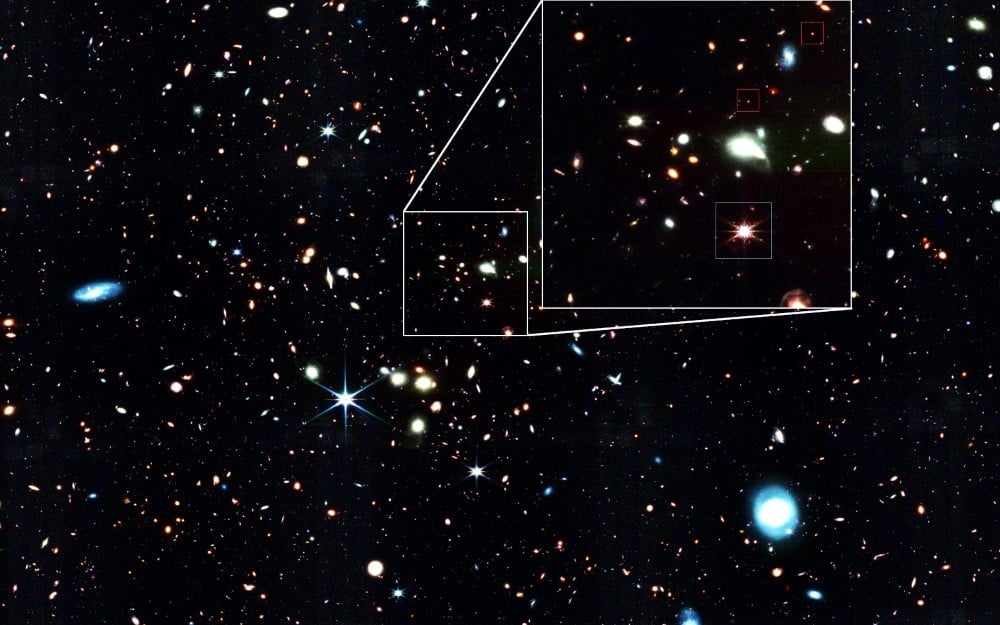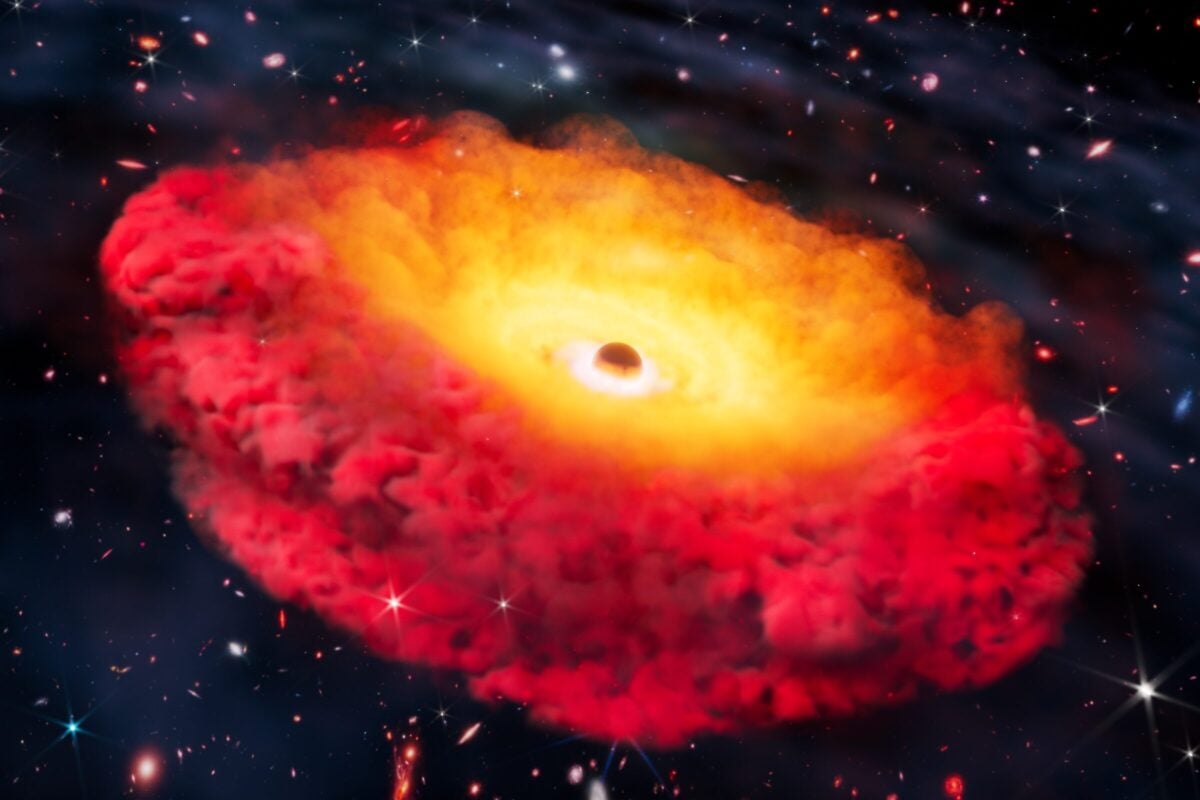In 2024, an international team of astronomers launched the CANDELS-Area Prism Epoch of Reionization Survey (CAPERS), a program that would use data from the James Webb Space Telescope (JWST) to identify galaxies at “Cosmic Dawn.” This cosmological period took place less than one billion years after the Big Bang and is when the first galaxies in the Universe formed. In a recent study, the CAPERS team confirmed the existence of a black hole at the center of a galaxy (designated CAPERS-LRD-z9) roughly 13.3 billion light-years away.
This makes the black hole the earliest ever observed by scientists, and presents opportunities to study the evolution of black holes and the structure of the Universe during this early period. The research was led by Anthony J. Taylor, a postdoctoral candidate at the University of Texas at Austin’s Cosmic Frontier Center, and included several members of the CAPERS consortium. The paper detailing their findings was published on August 6th in The Astrophysical Journal Letters.
During the 1970s, scientists discovered that most massive galaxies have a central supermassive black hole (SMBH), which explained why their core regions would periodically become bright enough to outshine all the stars in their disks. This led to the term Active Galactic Nuclei (AGN), which describes these bright galactic centers and differentiates them from less bright and active galaxies. With the deployment of Webb, astronomers are finally getting the chance to observe the early ancestors (or “seeds”) of these behemoths and study how they have influenced the evolution of their galaxies.
“Little Red Dot” galaxies appear in large numbers roughly 600 million years after the Big Bang. Credit: NASA/ESA/CSA/STScI/Dale Kocevski (Colby College).
CAPERS-LRD-z9 was first identified by the Public Release IMaging for Extragalactic Research (PRIMER) survey using Webb’s Near-Infrared Camera (NIRCam) and Mid-Infrared Instrument (MIRI). Like many galaxies identified by Webb, CAPERS-LRD-z9 is part of a new class of galaxies known as “Little Red Dots” that existed 1.5 billion years after the Big Bang, which are very compact, red, and surprisingly bright. While conducting follow-up observations, the CAPERS team identified the tell-tale signs of fast-moving gas using Webb’s Near-Infrared Spectrometer (NIRSpec) to conduct NIRSpec/PRISM spectroscopy.
As gas and dust circle a black hole and accrete onto its face, it is accelerated to relativistic speeds (close to the speed of light). Whereas gas flowing away relative to our instruments is shifted towards the red end of the spectrum, gas moving towards them is shifted to bluer wavelengths. When they examined the spectral signatures coming from CAPERS-LRD-z9, the team detected the presence of both, confirming that they had identified a black hole roughly 13.3 billion light-years away. While astronomers have found a few more distant candidates, they have not yet found the distinctive spectroscopic signature associated with black holes.
“When looking for black holes, this is about as far back as you can practically go. We’re really pushing the boundaries of what current technology can detect,” said Taylor in a UT News release. “The first goal of CAPERS is to confirm and study the most distant galaxies,” added co-author Mark Dickinson, the CAPERS team lead. “JWST spectroscopy is the key to confirming their distances and understanding their physical properties.”
The presence of an SMBH seed at the center of CAPERS-LRD-z9 presents astronomers with a unique opportunity to do that. For one, this galaxy supports the theory that SMBHs are the source of the unexpected brightness of Little Red Dots, which is typically attributed to an abundance of stars. However, this is inconsistent with current cosmological models that suggest these galaxies did not have enough time to form so many stars. Furthermore, black holes shine brightly because they compress the gas and dust they consume, releasing tremendous amounts of light and heat.
 The little red dots could represent galaxies that are in an evolutionary phase predating the luminous quasar phase. Credit: NASA/ESA/CSA/ISTA)/ETH Zurich/NAOJ
The little red dots could represent galaxies that are in an evolutionary phase predating the luminous quasar phase. Credit: NASA/ESA/CSA/ISTA)/ETH Zurich/NAOJ
Confirming the existence of an SMBH seed in CAPERS-LRD-z9 helps illustrate this process in very early galaxies. This galaxy could also help explain the distinct red color in LRD galaxies, which could be due to a thick cloud of dust surrounding the black hole – something that has been observed in more recent galaxies. In addition, the size of the black hole (up to 300 million times the mass of our Sun) was an unexpected find, roughly half the mass of all the stars in its disk. This is similar to what astronomers noticed with other SMBH seeds in galaxies that existed less than 1 billion years after the Big Bang.
Therefore, this finding also presents astronomers with an opportunity to study how these black holes could have grown so large so quickly. “This adds to growing evidence that early black holes grew much faster than we thought possible,” said co-author Finkelstein, the director of the Cosmic Frontier Center. “Or they started out far more massive than our models predict.”
Looking ahead, the team hopes to gather more high-resolution data on CAPERS-LRD-z9 to learn more about the role black holes played in the development of galaxies in the early Universe. “This is a good test object for us,” said Taylor. “We haven’t been able to study early black hole evolution until recently, and we are excited to see what we can learn from this unique object.”
Further Reading: UT News, The Astrophysical Journal Letters
